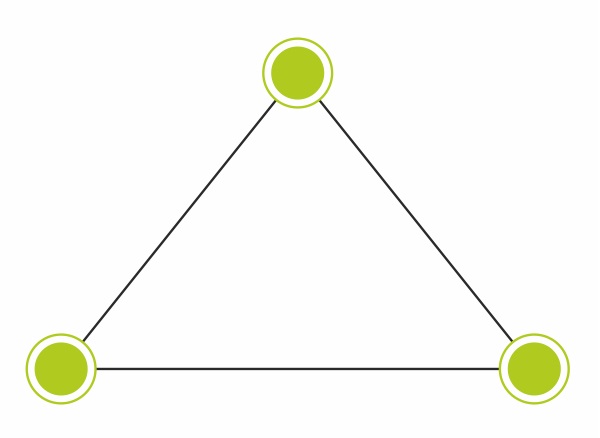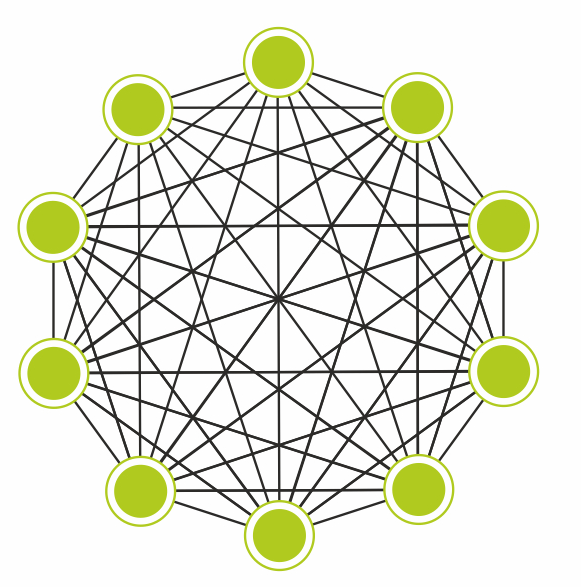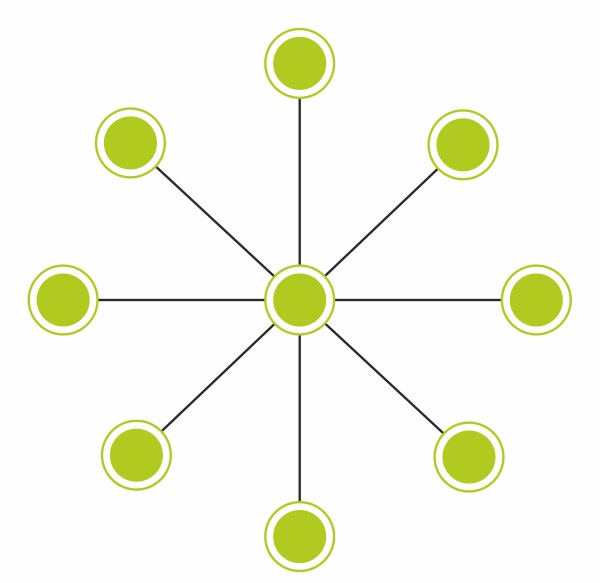How to lead complex technical projects without hiring PMs: DataLine experience
DataLine began with traditional colocation and telecom. Then cloud computing was added to them. Now we are administering infrastructure, databases, information security services, applications and entire web projects. Together with the number of services, our production has also grown - as we call the engineering departments of the company.
Small branch # 10yearschallenge. This is how the production management grew.
Today, most client cases involve the competence of 2-3 production departments. For example, the client has a pool of resources in the cloud. These are already two departments - virtualization and network.

When there are only three departments in a project, it is not so difficult to coordinate.
But there are truly complex projects that most of the existing engineering departments are working on. For example, let's add backup, OS administration, databases, web applications, information security tools, monitoring to the lease of virtual resources, and we get something like a complex project involving eight engineering departments.

When a dozen technical departments are involved in a project, it is difficult to coordinate project activities.
On such projects it is difficult to cope only with the help of standard regulations and processes. When it comes to complex changes in the operational phase, additional coordination is needed. To implement a major change in the architecture, it is necessary to distribute the tasks to the core departments, then make it so that all technical departments in a certain sequence or in parallel make their own piece. And still keep in touch with the technical specialists of the client, well, in general, keep an eye on the technical part of the project.
For all this, the company has a new role - Technical Account Manager, or simply TAM.
Recently, I supervise the work of these guys and today I will tell you more about them.

When a client only comes to us, an architect works with him. He translates the client's business problems into the language of our services and develops a solution.
He coordinates the work of the technical departments during the design phase of the architecture and manages the implementation. After putting the project into operation, the architect switches to new clients.
Next client support:
It turns out such a hybrid of PM and PreSale, but also a practicing engineer. Now more about each of the components of the role of Technical Account Manager.
Project manager. When the client receives a request to “prepare the technological landscape for a new project (network + virtual resources + OS + nginx + php)”, TAM finds out the details, terms. Then he breaks the overall task and distributes its pieces to the necessary engineering departments. It is not uncommon for departments to solve a chain problem: one department cannot get to work until another one does its part. In such cases, TAM steers terms and statuses.
In order to implement a new project, TAM must be aware of what is happening in it now and what has been done so far. It aggregates and updates, if necessary, all project documentation and is further responsible for its relevance.
Chief of technical part. The client can safely send to TAM all technical questions concerning the current project, and not only. He will also listen to any wishes and plans and select a solution. In order to solve issues quickly, TAM will be in touch not only with the client’s managers, but also with its technical specialists.
Since TAM thoroughly knows the technical part of the project, he is aware of the problems and potential points for development: the client is about to lack resources, the infrastructure has become inconvenient to scale. It happens that a client does not have any task at all. For example, a couple of times a month the client had high-level ddos attacks. The client himself still does not feel this at all, only the traffic surgeon sees this. He will point out the problem, explain reasonably the risks and propose a solution: “Yes, now you do not notice these attacks, as this is only probing, but they repeat. The next attack may turn out to be strong, and everything will be put. If a simple service is critical for this service, then you should consider protecting it. ”
By the way, we did not limit the story with the support of the initiative from engineers only to TAMs. Any engineer can suggest improvements in the client’s project. If the client implements the proposed changes, the engineer receives a bonus.
Quality manager. TAM regularly collects statistics on completed incidents and analyzes the quality of technical support work. The most important indicators on control are the reaction time and incident resolution. If he finds violations, TAM examines them in detail, ascertains the causes andpunishes the guilty, suggests changes in the processes and regulations so that there will be no such thing.
If an accident occurs, the debriefing takes place immediately after the elimination of its consequences.
When we discussed the need to somehow coordinate the project during the operational phase, a separate division with PMs was suggested. But there were fears that this department would also fall into the maelstrom between the technical departments, and we wanted to get out of it. In addition, this is a pilot topic, and we decided not to produce entities and implemented this idea within the framework of existing departments using the role.
I talked to each technical department separately, told them what TAM would do and under what conditions. Then anyone who was interested in my proposal could come to the interview. When selecting in addition to confident knowledge in their field, we wanted to make sure that the engineer also knows a little about related areas. If it is a networker, then he must understand how virtualization works. They evaluated how the engineer knows how to communicate (communicate his point of view, argue for it), act as the lead of the project and organize the joint work of specialists from several departments.
Of the 15 people, 10 were selected. Now TAMs are already 13. There are 4 more on the way. The
engineer will deal with the duties of TAM about 30% of his working time and receive remuneration based on the results of his work.
The fact that TAMs are our engineers, not specialists from the market, helped us kill two birds with one stone:
We hope that with the help of TAMs we can:
The whole story with TAMs started in December and is only gaining momentum. The most interesting is feedback from customers, which we expect to receive in the coming months. We hope that customers will also appreciate our innovation.
| 2009 | 2019 |
| Network team Duty engineers Infrastructure operations department | Network team VMware virtualization team Hyper-V virtualization team Backup group Microsoft group Monitoring group Unix group DBA group Cyber security center External data center management department Design center Architectural solutions department Software development group Infrastructure operations department Duty engineers Technical support service |
Today, most client cases involve the competence of 2-3 production departments. For example, the client has a pool of resources in the cloud. These are already two departments - virtualization and network.

When there are only three departments in a project, it is not so difficult to coordinate.
But there are truly complex projects that most of the existing engineering departments are working on. For example, let's add backup, OS administration, databases, web applications, information security tools, monitoring to the lease of virtual resources, and we get something like a complex project involving eight engineering departments.

When a dozen technical departments are involved in a project, it is difficult to coordinate project activities.
On such projects it is difficult to cope only with the help of standard regulations and processes. When it comes to complex changes in the operational phase, additional coordination is needed. To implement a major change in the architecture, it is necessary to distribute the tasks to the core departments, then make it so that all technical departments in a certain sequence or in parallel make their own piece. And still keep in touch with the technical specialists of the client, well, in general, keep an eye on the technical part of the project.
For all this, the company has a new role - Technical Account Manager, or simply TAM.
Recently, I supervise the work of these guys and today I will tell you more about them.

What will TAM do?
When a client only comes to us, an architect works with him. He translates the client's business problems into the language of our services and develops a solution.
He coordinates the work of the technical departments during the design phase of the architecture and manages the implementation. After putting the project into operation, the architect switches to new clients.
Next client support:
- Service managers: they are responsible for organizational issues, documents, communicate with decision makers.
- Technical departments: responsible for technical support.
- Technical Account Manager: отвечает за всю техническую часть по проекту. Его основная задача – координация крупных технических изменений в проекте. Он будет взаимодействовать с клиентом по техническим вопросам, в том числе вносить предложения по оптимизации архитектуры клиента в соответствии с его задачами. Еще одна функция ТАМ – контроль выполнения SLA.
It turns out such a hybrid of PM and PreSale, but also a practicing engineer. Now more about each of the components of the role of Technical Account Manager.
Project manager. When the client receives a request to “prepare the technological landscape for a new project (network + virtual resources + OS + nginx + php)”, TAM finds out the details, terms. Then he breaks the overall task and distributes its pieces to the necessary engineering departments. It is not uncommon for departments to solve a chain problem: one department cannot get to work until another one does its part. In such cases, TAM steers terms and statuses.
In order to implement a new project, TAM must be aware of what is happening in it now and what has been done so far. It aggregates and updates, if necessary, all project documentation and is further responsible for its relevance.
Chief of technical part. The client can safely send to TAM all technical questions concerning the current project, and not only. He will also listen to any wishes and plans and select a solution. In order to solve issues quickly, TAM will be in touch not only with the client’s managers, but also with its technical specialists.
Since TAM thoroughly knows the technical part of the project, he is aware of the problems and potential points for development: the client is about to lack resources, the infrastructure has become inconvenient to scale. It happens that a client does not have any task at all. For example, a couple of times a month the client had high-level ddos attacks. The client himself still does not feel this at all, only the traffic surgeon sees this. He will point out the problem, explain reasonably the risks and propose a solution: “Yes, now you do not notice these attacks, as this is only probing, but they repeat. The next attack may turn out to be strong, and everything will be put. If a simple service is critical for this service, then you should consider protecting it. ”
By the way, we did not limit the story with the support of the initiative from engineers only to TAMs. Any engineer can suggest improvements in the client’s project. If the client implements the proposed changes, the engineer receives a bonus.
Quality manager. TAM regularly collects statistics on completed incidents and analyzes the quality of technical support work. The most important indicators on control are the reaction time and incident resolution. If he finds violations, TAM examines them in detail, ascertains the causes and
If an accident occurs, the debriefing takes place immediately after the elimination of its consequences.
Not a position, but a role
When we discussed the need to somehow coordinate the project during the operational phase, a separate division with PMs was suggested. But there were fears that this department would also fall into the maelstrom between the technical departments, and we wanted to get out of it. In addition, this is a pilot topic, and we decided not to produce entities and implemented this idea within the framework of existing departments using the role.
I talked to each technical department separately, told them what TAM would do and under what conditions. Then anyone who was interested in my proposal could come to the interview. When selecting in addition to confident knowledge in their field, we wanted to make sure that the engineer also knows a little about related areas. If it is a networker, then he must understand how virtualization works. They evaluated how the engineer knows how to communicate (communicate his point of view, argue for it), act as the lead of the project and organize the joint work of specialists from several departments.
Of the 15 people, 10 were selected. Now TAMs are already 13. There are 4 more on the way. The
engineer will deal with the duties of TAM about 30% of his working time and receive remuneration based on the results of his work.
The fact that TAMs are our engineers, not specialists from the market, helped us kill two birds with one stone:
- we got a technically savvy specialist with established connections within the company, especially with other technical departments;
- The engineer will be able to try himself in the role of PM and pump over new skills. The guys will have a lot of training courses on internal information systems that they will use in their work, lectures from leading engineers of the company, courses on public speaking and negotiation.
What is the profit from TAM?
We hope that with the help of TAMs we can:
- Better understand customer needs and act proactively on the project.
- Establish communication between customer technicians and our engineers. Ideally, we want to come to the point that TAMs communicate with technicians, and service managers - with decision makers.
- Remove the burden from service managers. They will be less involved in technical details of projects and will be able to concentrate on their primary tasks - retention and development of clients.
- Hone internal production processes.
The whole story with TAMs started in December and is only gaining momentum. The most interesting is feedback from customers, which we expect to receive in the coming months. We hope that customers will also appreciate our innovation.
